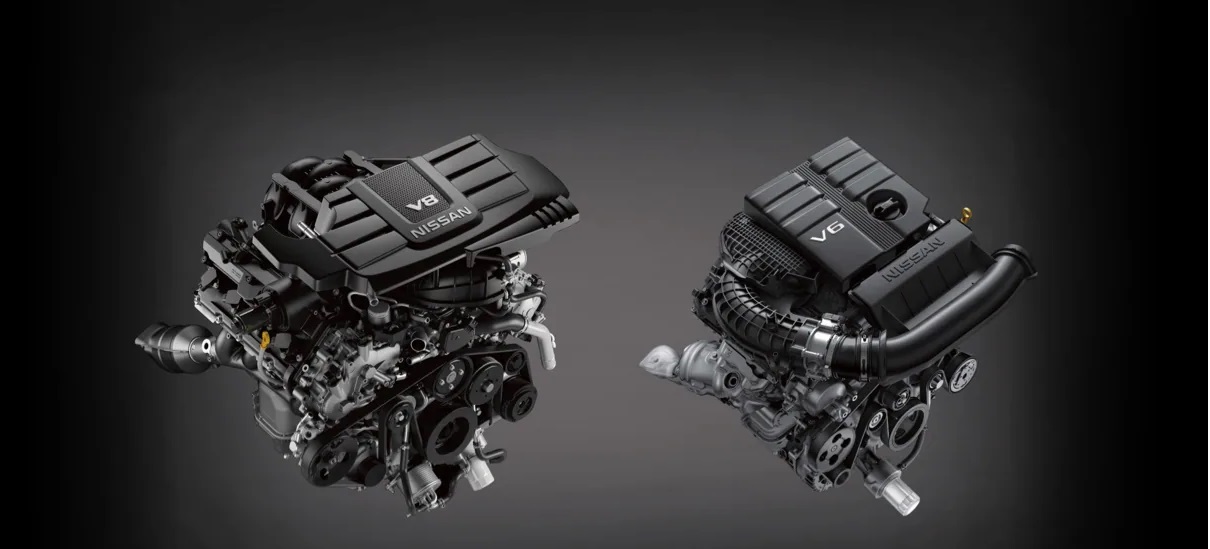The debate between V8 and V6 engines has spanned decades and remains a critical consideration, especially in regions like the UAE, where off-roading is an integral part of the driving culture.
Historically, V8 engines have been synonymous with raw power and performance, particularly in large SUVs. However, as technology has advanced, several manufacturers have shifted to V6 engines without significantly compromising on power. Models like the Toyota Land Cruiser, Nissan Patrol, and Ford Expedition are prime examples of this trend, prioritizing fuel efficiency and emissions reduction while maintaining impressive performance.
In this article, we will break down the critical differences between V8 and V6 engines, focusing on power, torque, fuel efficiency, and their respective suitability for SUVs.
Transition to V6 Engines
In recent years, several large SUV models have transitioned from V8 to V6 engines due to advancements in engine technology. This shift has allowed V6 engines to match or even exceed the performance of older V8 engines while offering better fuel efficiency and lower emissions.
For example, the 2022 Toyota Land Cruiser introduced a 3.5-liter twin-turbo V6 that generates 409 horsepower and 650 Nm of torque, replacing its older 5.7-liter V8 that produced 381 horsepower and 544 Nm of torque. Similarly, the 2025 Nissan Patrol features a 3.5-liter V6, delivering up to 425 horsepower and 700 Nm of torque, showcasing a clear performance upgrade despite downsizing. Meanwhile, the 2024 Ford Expedition has also embraced the V6 engine, offering a 3.5-liter V6 with up to 440 horsepower and 691 Nm of torque in its most powerful variants.
These changes demonstrate how V6 engines can rival or even outperform older V8 models in terms of power and torque, providing SUV drivers with enhanced performance and efficiency.
The V8 Holdouts: Dodge and General Motors
Despite the industry shift toward V6 engines, some manufacturers like Dodge and General Motors (GM) continue to offer V8-powered SUVs. Vehicles such as the Dodge Durango, Chevrolet Tahoe, and GMC Yukon still come equipped with V8 engines, offering impressive power and torque for those who prioritize these characteristics.
For instance, the 2024 Dodge Durango SRT 392 features a 6.4-liter V8 engine, delivering 475 horsepower and 637 Nm of torque, making it a standout for drivers seeking high-performance SUVs. Similarly, GM’s Chevrolet Tahoe and GMC Yukon offer a 5.3-liter V8 engine that produces 355 horsepower and 518 Nm of torque. An optional 6.2-liter V8 version boosts power output to 420 horsepower and 624 Nm of torque.
These V8-powered models continue to appeal to enthusiasts who value raw power and the unmistakable sound of a V8 engine.
Power and Torque
When comparing power and torque between V6 and V8 engines, V8s typically lead the way, offering higher torque output, which is particularly useful for towing, off-roading, and heavy-duty driving. However, advancements in turbocharging technology have allowed modern V6 engines to close the gap significantly.
The Ford Expedition and Toyota Land Cruiser are prime examples of SUVs with turbocharged V6 engines that deliver competitive horsepower and torque figures, allowing them to perform on par with V8-equipped models in many situations. Turbocharged V6 engines, like the one in the Expedition, offer faster torque delivery due to forced induction, making them suitable for various driving conditions, including towing and off-roading.
While V8 engines may still be preferred for their raw power, modern V6 engines offer a compelling balance of performance, torque, and fuel efficiency.
Fuel Efficiency Comparison
One of the primary reasons for the shift from V8 to V6 engines is improved fuel efficiency. In an era where environmental concerns are growing, automakers are keen to offer more fuel-efficient vehicles without sacrificing performance.
For example, the 2022 Toyota Land Cruiser’s 3.5-liter twin-turbo V6 offered a combined fuel economy of approximately 10.6-10.8 km/l, compared to the older V8 model’s 7.5 km/l. This improvement highlights the advantages of switching to a V6 engine, especially for consumers concerned with long-term fuel costs.
However, the situation is not always so clear-cut. In some cases, V8 engines can still compete with V6 engines in terms of fuel efficiency. For example, the Chevrolet Tahoe with its V8 engine achieves fuel economy ranging from 7.9 to 9.7 km/l, which compares favorably to the Ford Expedition’s V6 that delivers between 5.9 and 9.1 km/l. Factors such as driving conditions, engine tuning, and vehicle weight play a significant role in these differences.
In general, though, V6 engines tend to offer better fuel economy than their V8 counterparts, making them more suitable for daily driving and long-distance travel.
Off-Road Perspective
Off-roading is a popular activity in the UAE, and choosing between a V8 and V6 engine can significantly impact performance in challenging terrains. V8 engines typically offer more low-end torque, which is beneficial for climbing steep slopes or traversing rocky landscapes. However, modern turbocharged V6 engines provide a competitive alternative with impressive torque figures and quicker torque delivery due to forced induction.
For example, the Nissan Patrol’s V6 engine delivers enough torque for moderate off-roading, though it may feel underpowered compared to V8 models like the Chevrolet Tahoe in more extreme off-road conditions. On the other hand, the twin-turbo V6 engines in the Toyota Land Cruiser and Ford Expedition offer excellent performance in most off-road scenarios while providing better fuel efficiency for extended trips.
Ultimately, the choice between a V8 and V6 for off-roading depends on your specific needs. If you frequently engage in heavy-duty off-road activities, a V8 may still be the better option. However, for those who want a balance between off-road capability and fuel efficiency, a turbocharged V6 engine can offer a compelling solution.
Conclusion: What’s the Best Choice?
Deciding between a V8 and V6 engine depends on your driving habits, performance needs, and environmental considerations. If raw power and torque are your primary concerns, particularly for towing or off-roading, a V8 engine may still be the best option. However, if you’re looking for a balance between performance and fuel efficiency, the latest generation of turbocharged V6 engines offers an excellent alternative.
Manufacturers like Dodge and General Motors continue to champion the V8, while brands like Toyota, Nissan, and Ford demonstrate that V6 engines are more than capable of delivering impressive performance with the added benefits of fuel efficiency and lower emissions.
Whether you choose a V8 or V6, both engine configurations have their advantages, and the choice ultimately comes down to your specific driving needs and preferences.
Stay tuned to carprices.ae for more updates on engine technology, SUV reviews, and the latest trends in the automotive world.


